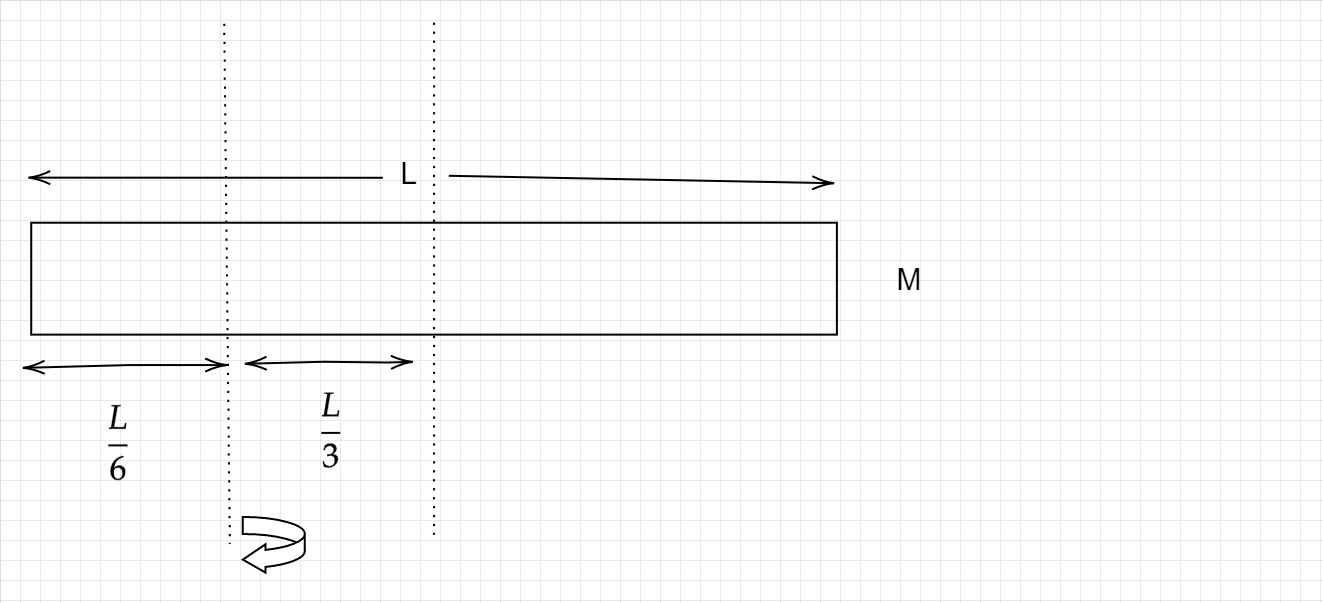Question
Question: What is the MOI of the following:- 
Solution
First taking the moment of inertia formula and defining the initial variables/terms with some basic knowledge. Then, assuming the axis to be in center first and solving the equation as when the object is rotating on the axis. Afterwards, solving the equation when the axis is further than center as described in the diagram.
Complete step-by-step solution:
The moment of inertia (MOI) in the diagram,
The formula of MOI is,
I$$$$=$$$${{r}^{2}}m
Where, m is sum of the product of mass, r= distance from the axis of rotation, and integral form: I=∫dl
The role of MOI is the same as the role of mass in linear motion.
Taking mass as M and length as L, distributed mass as dm and distributed length as dl
Assuming the axis to be the center of the rectangle object, it has a uniform speed. Thus, the density remains unchanged.
\dfrac{M}{L}$$$$=$$$$\dfrac{dm}{dl}
Moving dlon other side:
dm$$$$=$$$$\left( \dfrac{M}{L} \right)$$$$dl
When the mass is distributed in more complicated way at different distances from the rotation axis:
I$$$$=$$$$\int{{{r}^{2}}}dm
Replacing the value of dm in this formula:
{{I}_{cm}}$$$$=$$$$\int\limits_{0}^{M}{{{r}^{2}}}dm
Changing dm to dl also changes the integration value into length:
{{I}_{cm}}$$$$=$$$$\int\limits_{\dfrac{-L}{2}}^{\dfrac{L}{2}}{{{I}^{2}}}\left( \dfrac{M}{L} \right)dl
Applying integration to it
=$$$$\dfrac{M}{L}$$$${}_{\dfrac{-L}{2}}^{\dfrac{L}{2}}\left[ \dfrac{{{I}^{3}}}{3} \right]
=$$$$\dfrac{M}{3L}\left[ {{\left( \dfrac{L}{2} \right)}^{3}}-{{\left( \dfrac{-L}{2} \right)}^{3}} \right]
=$$$$\dfrac{M}{3L}\left[ \dfrac{{{L}^{3}}}{8}+\dfrac{{{L}^{3}}}{8} \right]
=$$$$\dfrac{M}{3L}\left[ \dfrac{2{{L}^{3}}}{8} \right]
Terminating denominatorL with one of L on numerator and further solving the equation:
=$$$$\dfrac{1}{12}M{{L}^{2}}
Thus, deriving this formula
{{I}_{cm}}$$$$=$$$$\dfrac{1}{12}M{{L}^{2}}
Where Icm is the moment of inertia in the center of the axis.
According to parallel axis theorem,

In a given rotation axis direction, the moment of inertia increases as the axis becomes further than the center. Thus, the moment of inertia of the rectangle object when the axis is some distance further than center then it’s MOI of center axis with MOI of axis of distance d from center. So the formula is
I$$$$=$$$${{I}_{cm}}$$$$+$$$$M{{d}^{2}}.
Where d is the distance between the center axis and given axis. Thus, d =$$$$\dfrac{L}{3}
And mass is M same as above
I$$$$=$$$${{I}_{cm}}+M(3L)2
Putting, MOI of center axis.
I$$$$=$$$$\dfrac{1}{12}M{{L}^{2}}+M{{\left( \dfrac{L}{3} \right)}^{2}}
Solving the above equation, we get:
=$$$$\dfrac{7M{{L}^{2}}}{36}
The moment of inertia in the rectangle object is 367ML2.
Note: The moment of inertia depends on the following factors like: The density of the material, Shape and size of the body, Axis of rotation (distribution of mass relative to the axis). Moment of inertia is usually specified with respect to a chosen axis of rotation. It mainly depends on the distribution of mass around an axis of rotation.
